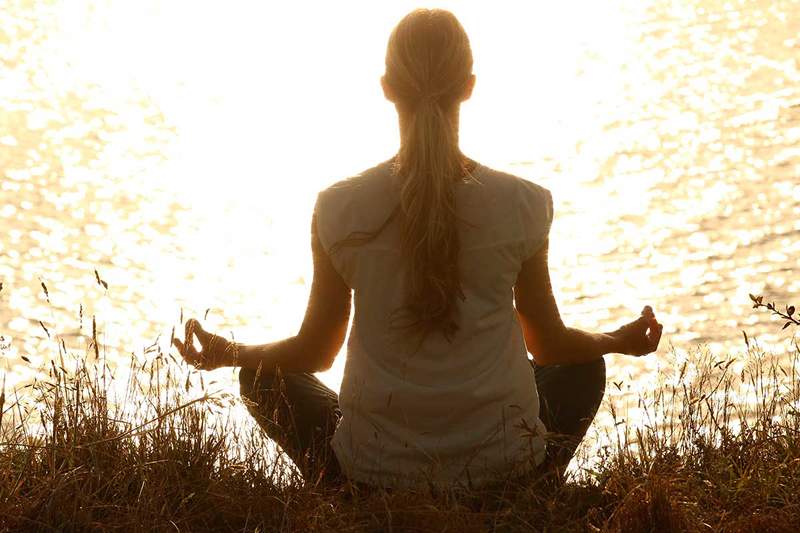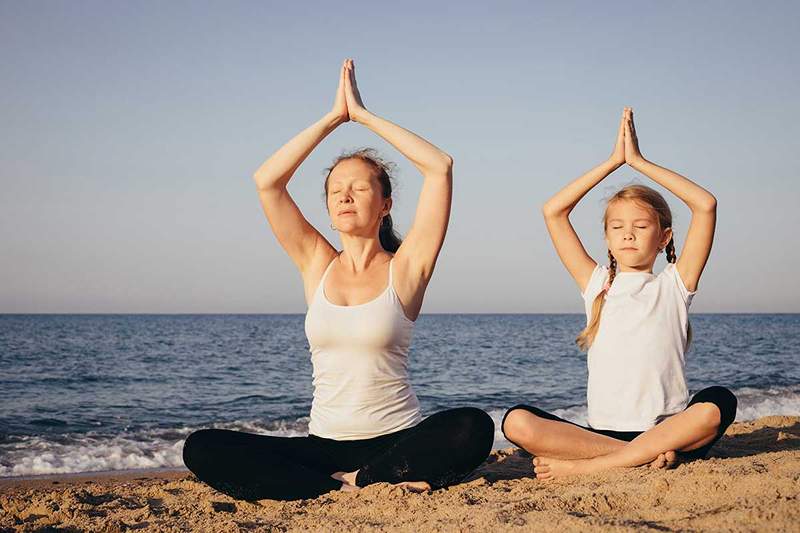Visualization meditation exercises

- 4084
- 638
- Austin Stokes
Visualization is a very effective technique that is used in therapy as a tool for reduce the physiological activation that appears in moments of anxiety, and thus achieve a state of relaxation.
Content
Toggle- What are visualization techniques
- What are visualization techniques for
- 12 visualization exercises
- 1. Liberation of thoughts
- 2. Interaction between tension and relaxation
- 3. Drive your tension
- 4. Colors
- 5. Muscle tension
- 6. Directed images
- 7. The path on the mountain
- 8. Active memory technique
- 9. Face the unknown
- 10. Create your own images
- eleven. Exercises of the five fingers of the hand
- 12. Deep relaxation with visualization suggestion
What are visualization techniques
Visualization techniques work with the neuronal connections that exist between the motor and emotional areas of our brain. What is about achieving with this type of technique is connect certain images and thoughts with positive moods.
Visualization basically consists of evoking with the imagination a pleasant situation or scene and Use positive emotions that occur to change thought patterns, or simply to enjoy the welfare state that appears.
What are visualization techniques for
Practice the visualization techniques regularly will help us deepen more and more in the sensations and symbols that accompany each image. Over time, when we are trained, we can memorize these visualizations and the relaxation states that accompany you, to use them when we need.
From the visualization of images, we can induce healthy moods that allow us both to relax and have pleasant sensations, since, as Carl Jung said, through the images we can connect the most unconscious part of our mind with the most conscious part.
Visualization techniques are used for the treatment of anxiety, phobias, low self -esteem, depression, physical and tension pain, etc.
We have made a small compilation of visualization exercises, which can serve you if you are therapist to use it in your sessions, or you can also use them on your own to help relax.
 The benefits of yoga in children
The benefits of yoga in children 12 visualization exercises
These are simple techniques that are used to Help us concentrate while we minimize our thoughts, emotions and physical pain.
1. Liberation of thoughts
Close your eyes ... imagine that you are sitting on the shore of a river looking how the trunk of a tree descends slowly carried by the current. During 6 to 10 seconds, imagine that a thought of yours, a perception or a sensation, travel on the trunk and then let both disappear from your sight. Contemplate again and wait for a new trunk that will carry a new thought on it.
You can also do this exercise imagining that your thoughts are snack of smoke that occur from a fire.
2. Interaction between tension and relaxation
Close your eyes ... look at the tension in your body ... choose a symbol to represent the tension or pain you experience at this time, it can be ice ... Choose another symbol that represents the concept of relaxation ..
Let both symbols interact so that, in the end, the tension is eliminated.
3. Drive your tension
Close your eyes ... Imagine a color and shape for your tension or pain ... now change the color and shape ... remove these last two elements until they disappear from your mind.
4. Colors
Close your eyes ... imagine that your body is full of lights. For example, a red light represents tension or pain and blue lights represent relaxation ... Imagine the lights changing from red to blue or from blue to red and observe any physical sensation that experienced in the meantime ... now imagine that all the lights From your body they have acquired a blue color and experiences the feeling of a total relaxation.
5. Muscle tension
Focus on that part of the body where you feel greater muscle tension ... Give a mental image to the tension, for example, a weight that oppresses your stomach, a string strongly knotted around the arms, a lock that closes your mouth, a lathe that squeezes your shoulders (depending on the place where you feel the tension) ... try to see the relaxation of this image. Imagine that you are slightly covered by a layer of warm sand ... your right leg ... the left ... the stomach ... the chest ... and the arms. Or imagine that a warm blanket, slowly ... slowly, you are covering your shoulders.

6. Directed images
This technique represents another very effective way to use imagination to achieve relaxation.
7. The path on the mountain
Close your eyes ... Imagine that you are departing from the place where you live ... leave behind the noise and the daily haste site to stop ... now find a path you can upload around ... look for a comfortable place to stop.
When you have found it and legacy to that point, take some time to examine all the tension in your life. Mentally grants tension and stress forms and colors ... look at them carefully and then leave them on the margin of the path in which you are.
Continue going up the road until you reach the top of a hill ... look from up there ... what do you see?… Look for an attractive and comfortable place and go towards him.
Look in the surroundings ... what do you remember?... look at the views, in the smells, in the sounds ... repair how you feel ... install yourself and, little by little, start relaxing ... now you feel totally relaxed ... experience the feeling of being total and completely relaxed ... rest of three Five minutes ... look around you again ..
Remember that this is your special place to relax the one you can come as long as you want.
Go back to your room again and say that all these images are the result of your imagination, you have created them and you can turn to them whenever you want to relax.
8. Active memory technique
Close your eyes ... Translate at the beginning of the day ... how was your waking?… How did you feel?... think about your thoughts and sensations ... Free yourself from these thoughts and sensations ... Free yourself from that part of the day ... belong to the past and you can no longer do anything to change it.
Now we are at eating time ... think about how your thoughts and sensations were ... how were the hours between 11:00 and 2:00?... free yourself from the thoughts and sensations of that part of the day ... both belong to the past ... you can't change them anymore.
Think now in the time between 2:00 and 5:00 in the afternoon ... how was that part of the day for you? Remember what your thoughts and sensations were ... free yourself from them ... Remember that both belong to the past ... you can't change them anymore.
Think now in the afternoon, in the hours elapsed between 5:00 and 7:00 in the afternoon ... how was that part of the day for you?... think about what you felt and thought about those hours ... free yourself from the thoughts and sensations you experienced during this time ... they belong to the past and you can no longer do anything to change them.
It's already 8:00 in the afternoon ... Quick relaxed ... feel totally relaxed.
9. Face the unknown
Close your eyes ... Imagine that you are in the forest ... It is dark and the wind blows ... you have lost ... what do you feel at this time?... Look at your body and the areas in which you feel tension ... experience it for a minute ..
Imagine that you find a place to get out of this dark and cold forest ... feel how the tension is disappearing from your body ... it will disappear as you find a path ... feel how the tension is being eliminated from your body ... you are relaxed ... you are sure … you feel comfortable.
10. Create your own images
The technique of directed images includes Find a comfortable position, close your eyes, concentrate on physical sensations and practice deep breath.
One way to create your own images is to attend any fantasy that goes to mind. For example, you may wonder how long the headache you feel at this time will last.
Close your eyes and let your imagination answer you to the question. Imagine different places: the beach, the streets of the city, a stream, etc. Among all the scenes you have imagined, choose one where to relax and from which only you will enjoy.
What smell do you perceive, how is the structure you see, how your body feels? Imagine that you are doing something that relaxes you, for example that you are fishing, that you are enjoying a good meal, chatting with friends, or that you are sitting by the fire, with a good book in your hands.
By the time you are installed in the scene you have imagined and you have relaxed in it, your headache will have already disappeared. In the space below, describe some images that are attractive to you. Tasty and record them in your memory. Every time you feel the need for a deep relaxation, close your eyes and move to that special place.
eleven. Exercises of the five fingers of the hand
The following exercise has been used successfully to induce relaxation.
- Touch the index finger with the thumb. Meanwhile, remember some situation in your past that the whole body has felt deep fatigue (while you uploaded a mountain, you did, you made footing, etc.)
- Touch the heart with the thumb. Meanwhile, it goes back to a time when you had some affective experience. It can be sexual, it can be a simple hug or even an intimate conversation.
- Touches the ring finger with the thumb. Meanwhile, think of the best fulfillment you have ever received. Try to accept it sincerely. In doing so, you are demonstrating a great esteem towards the person who received it, or you are; In turn, you are making yourself a compliment.
- Touch the little finger with the thumb. In doing so, think about the most beautiful place where you have been. Hold for a few moments.
This exercise of the five fingers has done less than ten minutes and in return provides greater vitality, an inner peace and the growth of self -esteem. You can do it every time you feel tension.
12. Deep relaxation with visualization suggestion
This Relaxation exercise is used in people who, in principle, find it difficult to visualize, since it is very suggestive. Therapists also use when they want to induce deep relaxation.
Close your eyes ... imagine that you walk through a dry and deserted place, it's hot ... and you feel your throat dry ... you display a glass full of water ... fresh water ... the glass has droplets outside and you know that it is fresh because the Crystal is tarnished ... you feel like swallowing ... but there is not enough saliva ... you continue with the dry and dry throat.
Then you remember the feeling that produces a piece of lemon between the teeth ... you slightly tighten your teeth and juice spread inside your mouth ... even falls through the corner of the lips ... your saliva increases ... more saliva and more saliva ... you have a Huge need to swallow, but don't swallow, there is more saliva, you will swallow when we have up to five:
- 1 hold the sensation
- 2 You are able to wait
- 3 There is little left
- 4 You feel the enormous need to swallow
- 5 You can swallow

